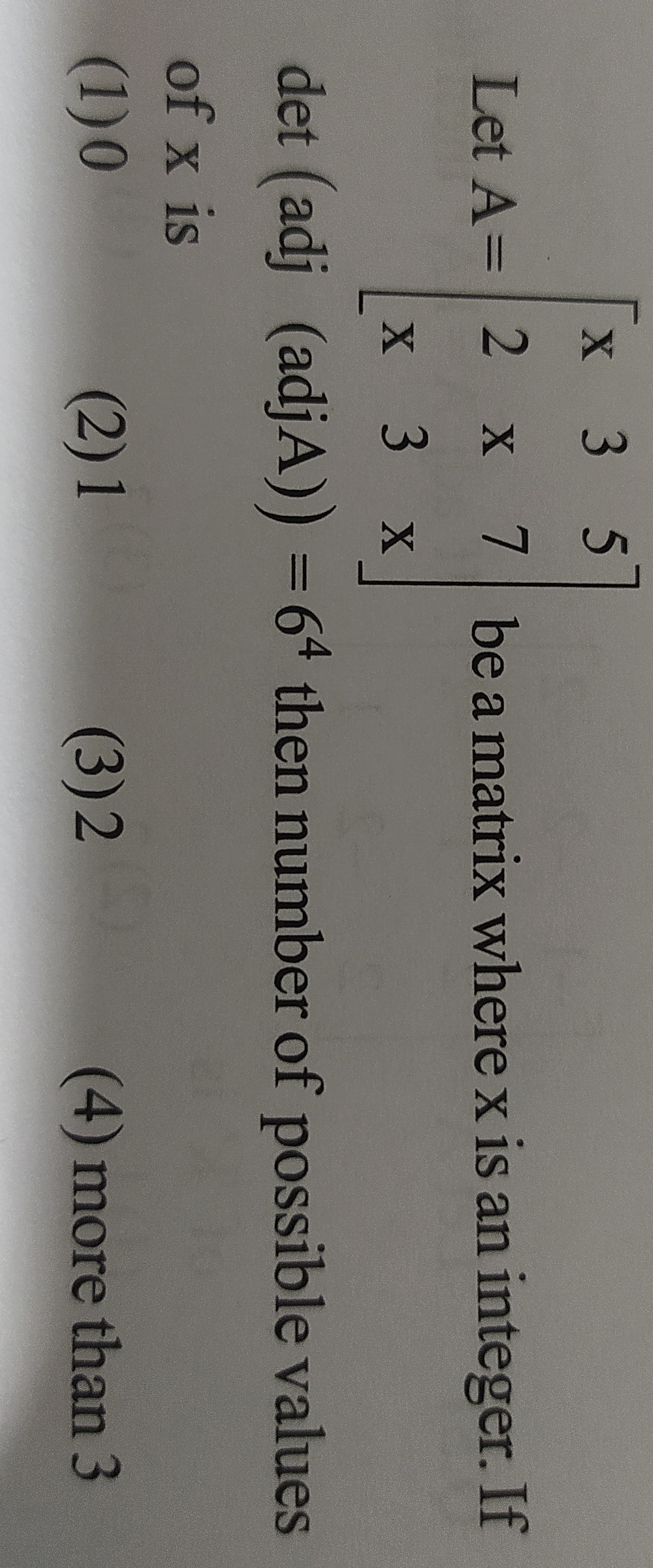Question
Question: Let $A = \begin{bmatrix} x & 3 & 5 \\ 2 & x & 7 \\ x & 3 & x \end{bmatrix}$ be a matrix where x is a...
Let A=x2x3x357x be a matrix where x is an integer. If det(adj(adjA)) = 64 then number of possible values of x is

0
1
2
more than 3
2
Solution
The given matrix is A=x2x3x357x. The order of the matrix is n=3. We are given that det(adj(adjA))=64.
For a square matrix A of order n, the determinant of the adjugate of the adjugate of A is given by the property: det(adj(adjA))=(detA)(n−1)2
In this case, n=3, so the formula becomes: det(adj(adjA))=(detA)(3−1)2=(detA)22=(detA)4.
We are given det(adj(adjA))=64. So, we have (detA)4=64. This equation implies detA=±6.
Now, we need to calculate the determinant of the matrix A in terms of x. detA=detx2x3x357x Expanding along the first row: detA=xx37x−32x7x+52xx3 detA=x(x⋅x−7⋅3)−3(2⋅x−7⋅x)+5(2⋅3−x⋅x) detA=x(x2−21)−3(2x−7x)+5(6−x2) detA=x3−21x−3(−5x)+30−5x2 detA=x3−21x+15x+30−5x2 detA=x3−5x2−6x+30
We have two possible cases for detA:
Case 1: detA=6 x3−5x2−6x+30=6 x3−5x2−6x+24=0 We are looking for integer solutions for x. We can test integer divisors of 24 as potential roots. Let P(x)=x3−5x2−6x+24. P(2)=23−5(22)−6(2)+24=8−5(4)−12+24=8−20−12+24=0. So, x=2 is an integer root. We can factor the polynomial using synthetic division or polynomial division. Dividing x3−5x2−6x+24 by (x−2):
2 | 1 -5 -6 24
| 2 -6 -24
----------------
1 -3 -12 0
The quotient is x2−3x−12. So, the equation is (x−2)(x2−3x−12)=0. The roots are x=2 or x2−3x−12=0. For the quadratic equation x2−3x−12=0, the discriminant is Δ=(−3)2−4(1)(−12)=9+48=57. Since 57 is not a perfect square, the roots x=23±57 are not integers. Thus, the only integer solution from Case 1 is x=2.
Case 2: detA=−6 x3−5x2−6x+30=−6 x3−5x2−6x+36=0 We are looking for integer solutions for x. We can test integer divisors of 36 as potential roots. Let Q(x)=x3−5x2−6x+36. Q(3)=33−5(32)−6(3)+36=27−5(9)−18+36=27−45−18+36=63−63=0. So, x=3 is an integer root. We can factor the polynomial using synthetic division or polynomial division. Dividing x3−5x2−6x+36 by (x−3):
3 | 1 -5 -6 36
| 3 -6 -36
----------------
1 -2 -12 0
The quotient is x2−2x−12. So, the equation is (x−3)(x2−2x−12)=0. The roots are x=3 or x2−2x−12=0. For the quadratic equation x2−2x−12=0, the discriminant is Δ=(−2)2−4(1)(−12)=4+48=52. Since 52 is not a perfect square, the roots x=22±52=22±213=1±13 are not integers. Thus, the only integer solution from Case 2 is x=3.
The possible integer values of x for which det(adj(adjA))=64 are x=2 and x=3. The number of possible values of x is 2.
The final answer is 2.
Explanation of the solution:
- Use the property det(adj(adjA))=(detA)(n−1)2 for an n×n matrix A.
- For the given 3×3 matrix (n=3), this simplifies to det(adj(adjA))=(detA)4.
- Given det(adj(adjA))=64, we get (detA)4=64, which implies detA=±6.
- Calculate the determinant of the matrix A in terms of x: detA=x3−5x2−6x+30.
- Set detA=6 and solve the cubic equation x3−5x2−6x+24=0 for integer values of x. The only integer solution is x=2.
- Set detA=−6 and solve the cubic equation x3−5x2−6x+36=0 for integer values of x. The only integer solution is x=3.
- The possible integer values of x are 2 and 3. The number of such values is 2.
The final answer is 2.
